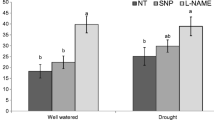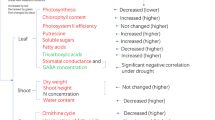Abstract
Colonization of arbuscular mycorrhizal fungi Glomus mosseae or exogenous salicylic acid (SA) treatment can increase Avena nuda plant tolerance to elevated NO2 exposure. The combination of the two factors, namely application of SA to the mycorrhizal plants, further promoted NO2 tolerance, as indicated by an alleviated plant biomass decrease compared to the respective treatment. The analysis of antioxidant capacity, redox status and photon energy utilization showed that the increased NO2 tolerance in the treated plants may be associated, at least in part, with scavenging reactive oxygen species, maintaining CO2 assimilated rate and reducing conditions in cells.



Similar content being viewed by others
References
Aebi HE (1983) Catalase. In: Bergmeyer HU (ed) Methods of enzymatic analyses. Verlag Chemie, Weinheim, pp 273–282
Ananieva EA, Christov KN, Popova LP (2004) Exogenous treatment with salicylic acid leads to increased antioxidant capacity in leaves of barley plants exposed to paraquat. J Plant Physiol 161:319–328
Beyer WF, Fridovich I (1987) Assaying for superoxide dismutase activity: some large consequences of minor changes in conditions. Anal Biochem 161:559–566
Bradford MM (1976) A rapid and sensitive method for the quantitation of microgram quantities of protein utilizing the principle of protein–dye binding. Anal Biochem 72:248–254
Foyer CH (2002) The contribution of photosynthetic oxygen metabolism to oxidative stress in plants. In: Inzé D, van Montagu M (eds) Oxidative stress in plants. Taylor and Francis, New York, pp 33–68
Griffith OW, Meister A (1979) Potent and specific inhibition of glutathione synthesis by buthionine sulfoximine (s–n-butylhomocysteine sulfoximine). J Biol Chem 254:7558–7560
Halim VA, Vess A, Scheel D, Rosahl S (2006) The role of salicylic acid and jasmonic acid in pathogen defence. Plant Biol 8:307–313
Hemeda HM, Klein BP (1990) Effects of naturally occurring antioxidants on peroxidase activity of vegetable extracts. J Food Sci 55:184–185
Huang LL, Yang C, Zhao Y, Xu X, Xu Q, Li GZ, Cao J, Herbert SJ, Hao L (2008) Antioxidant defenses of mycorrhizal fungus infection against SO2-induced oxidative stress in Avena nuda seedlings. Bull Environ Contam Toxicol 81:440–444
Maggs R, Ashmore MR (2004) Growth and yield responses of Pakistan rice (Oryza sativa L.) cultivars to O3 and NO2. Environ Pollut 127:403–410
Mateo A, Funck D, Mühlenbock P, Kular B, Mullineaux PM, Karpinski S (2006) Controlled levels of salicylic acid are required for optimal photosynthesis and redox homeostasis. J Exp Bot 57:1795–1807
Mittler R (2002) Oxidative stress, antioxidants and stress tolerance. Trends Plant Sci 7:405–410
Mou ZL, Fan WH, Dong X (2003) Inducers of plant systemic acquired resistance regulate NPR1 function through redox changes. Cell 113:935–944
Mukherjee SP, Choudhuri MA (1983) Implications of water stress induced changes in the levels of endogenous ascorbic acid and hydrogen peroxide in vigna seedlings. Physiol Plant 58:166–170
Muzika RM, Guyette RP, Zielonka T, Liebhold AM (2004) The influence of O3, NO2 and SO2 on growth of Picea abies and Fagus sylvatica in the Carpathian Mountains. Environ Pollut 130:65–71
Popova LP, Maslenkova LT, Yordanova RY, Ivanova AP, Krantev AP, Szalai G, Janda T (2009) Exogenous treatment with salicylic acid attenuates cadmium toxicity in pea seedlings. Plant Physiol Biochem 47:224–231
Rodriguez R, Redman R (2008) More than 400 million years of evolution and some plants still can’t make it on their own: plant stress tolerance via fungal symbiosis. J Exp Bot 59:1109–1114
Schaffer FQ, Buettner GR (2001) Redox environment of the cell as viewed through the redox state of the glutathione disulfide/glutathione couple. Free Rad Biol Med 30:1191–1212
Shalata A, Tal M (1998) The effect of salt stress on lipid peroxidation and antioxidants in the leaf of the cultivated tomato and its wild salt-tolerant relative Lycopersicon pennellii. Physiol Plant 104:167–174
Shimazaki K, Yu SW, Sakaki T, Tanaka K (1992) Differences between spinach and kidney bean plants in terms of sensitivity to fumigation with NO2. Plant Cell Physiol 33:267–273
Smith SE, Read DJ (1997) Mycorrhizal symbiosis, 2nd edn. Academic Press, San Diego, p 605
Takahashi M, Makagawa M, Sakamoto A, Ohsumi C, Matsubara T, Morikawa H (2005) Atmospheric nitrogen dioxide gas is a plant vitalization signal to increase plant size and the contents of cell constituents. New Phytol 168:149–154
Xu Q, Xu X, Zhao Y, Jiao K, Herbert SJ, Hao L (2008) Salicylic acid, hydrogen peroxide and calcium-induced saline tolerance associated with endogenous hydrogen peroxide homeostasis in naked oat seedlings. Plant Growth Regul 54:249–259
Yuan S, Lin HH (2008) Role of salicylic acid in plant abiotic stress. Z Naturforsch 63:313–320
Zhang ZL, Qu WJ (2003) Guide to plant physiology experiment, 3rd edn. Higher Education Press, Beijing, p 70
Zhao S, Qi X (2008) Signaling in plant disease resistance and symbiosis. J Integr Plant Biol 50:799–807
Acknowledgments
This research was supported by the National Natural Science Foundation of China (30570445) and Director Foundation of Experimental Centre, Shenyang Normal University (SY200802).
Author information
Authors and Affiliations
Corresponding author
Additional information
Runguo Li and Yangao Jiang contributed equally to this work.
Rights and permissions
About this article
Cite this article
Li, R., Jiang, Y., Xu, J. et al. Synergistic Action of Exogenous Salicylic Acid and Arbuscular Mycorrhizal Fungus Colonization in Avena nuda Seedlings in Response to NO2 Exposure. Bull Environ Contam Toxicol 84, 96–100 (2010). https://doi.org/10.1007/s00128-009-9895-1
Received:
Accepted:
Published:
Issue Date:
DOI: https://doi.org/10.1007/s00128-009-9895-1




